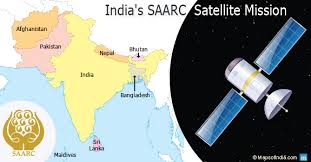SAARC Satellite
Launched in May 2017

SAARC Satellite:
- The “South Asia satellite” being built by India for use by countries of the South Asian Association for Regional Cooperation (SAARC) region
- Natural resources mapping, tele-medicine, the field of education, deeper IT connectivity or fostering people to people contact — this satellite will prove to be a boon in the progress of the entire region.
- It is an important step by India to enhance co-operation with the entire South Asia and is an appropriate example of our commitment towards South Asia
- The satellite called GSAT-09 enables full range of applications and services in the areas of telecommunication and broadcasting applications viz. Television, Direct-to-Home (DTH), Very Small Aperture Terminals (VSATs), Tele-education, Telemedicine and Disaster Management Support.
- The 2,230 kg satellite was built by the Indian Space Research Organisation (ISRO) and has 12 Ku-band transponders.
- It is cuboid in shape and built around a central cylinder has a mission life of over 12 years.
- It was launched from Satish Dhawan Space Centre in Sriharikota using a Geostationary Launch Vehicle (GSLV) Mk-II launch vehicle.
Issue:
As technological capabilities and innovation-led growth become important facets of economic and military power, countries have started integrating techno-diplomacy as a major piece in their broader international diplomacy edifice.
- Technological capabilities can serve both hard power (in military and economic terms), and soft power.
- While this is not an entirely new phenomenon, and has been used especially with nuclear technologies and military hardware and weapon systems, the role of civilian technology solutions in diplomacy has taken on a sense of urgency in the last decade or so.
- Due to technological and diplomatic constraints, India has generally been unable to wield its technology as an effective tool of diplomacy.
Diplomatic Significance:
The satellite is similar to previous communication satellites designed and launched by ISRO, and technologically does not constitute a major breakthrough. However, diplomatically, the South Asia satellite is significant for three reasons.
- First, it showcases India’s growing technological prowess.
- Along with previous missions such as Chandrayaan and the Mars Orbiter Mission, the South Asia satellite underscores the strength of Indian indigenous technological development.
- Second, that the satellite has been launched without any specific quid pro quo shows that India is willing to use its technological capabilities as a tool of diplomacy.
- India has begun realising that domestic technologies have now reached a level of maturity that allows India to confidently brandish its capabilities to other countries.
- It also serves as a marketing tool for future launches at a time when ISRO is building a strong niche for itself in the international satellite launch market.
- Third, it reveals both India’s ambition and capability to create what can be termed “technological commons”.
- By “gifting” this satellite to its neighbours, India has created an open access resource that can be leveraged by the latter to address some of their critical domestic concerns.
- Building such commons is essential not only to address immediate problems but also spur research, innovation and economic growth in the region.
Conclusion:
India must make a concerted effort to expand the range of technologies it can use as part of its diplomatic outreach. India could also look at including biotechnology and green energy. Unfortunately, there has been a critical lag in the evolution of robust scientific and research institutions in these areas, particularly from a funding standpoint. The South Asia satellite is emblematic of a more confident and assertive India, but it is necessary to ensure that such actions are not one-off.


